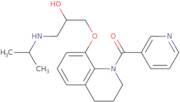
Informations sur le produit
- (+-)-1,2,3,4-Tetrahydro-8-(2-hydroxy-3-(isopropylamino)propoxy)-1-nicotinoylquinoline
- 1,2,3,4-Tetrahydro-8-(2-hydroxy-3-(isopropylamino)propoxy)-1-(3-pyridylcarbonyl)quinoline
- Methanone, [3,4-dihydro-8-[2-hydroxy-3-[(1-methylethyl)amino]propoxy]-1(2H)-quinolinyl]-3-pyridinyl-
- Nicainoprol [INN]
- Nicainoprolum
- Nicainoprolum [INN-Latin]
- Quinoline, 1,2,3,4-tetrahydro-8-[2-hydroxy-3-[(1-methylethyl)amino]propoxy]-1-(3-pyridinylcarbonyl)-
- Unii-1Ua960P80H
- [3,4-Dihydro-8-[2-hydroxy-3-[(1-methylethyl)amino]propoxy]-1(2H)-quinolinyl]-3-pyridinylmethanone
- {8-[2-hydroxy-3-(propan-2-ylamino)propoxy]-3,4-dihydroquinolin-1(2H)-yl}(pyridin-3-yl)methanone
- Voir d'autres synonymes
Nicainoprol is a cardiac glycoside that is used as an anti-arrhythmic agent. It binds to the phospholipid membranes of cardiac muscle cells and inhibits the enzyme creatine kinase, which is necessary for the transfer of high-energy phosphate groups in the myocardium. This inhibition leads to a decrease in the rate at which ATP is synthesized. Nicainoprol has dose-dependent effects on cardiac function, with low doses causing an inhibitory effect and higher doses inducing proarrhythmia. The mechanism of nicainoprol’s action has been elucidated by kinetic data obtained from reconstituted preparations and from erythrocyte ghosts incubated with this drug. Nicainoprol also inhibits fatty acid oxidation in skeletal muscle cells, leading to increased levels of acetyl-CoA and citrate in these cells.
Propriétés chimiques
Question d’ordre technique sur : 3D-BDA25206 Nicainoprol
Si vous souhaitez demander un devis ou passer commande, veuillez plutôt ajouter les produits souhaités à votre panier, puis demander un devis ou passer commande à partir de votre panier. C'est une méthode plus rapide, plus économique, et vous pourrez bénéficier des remises disponibles ainsi que d'autres avantages





